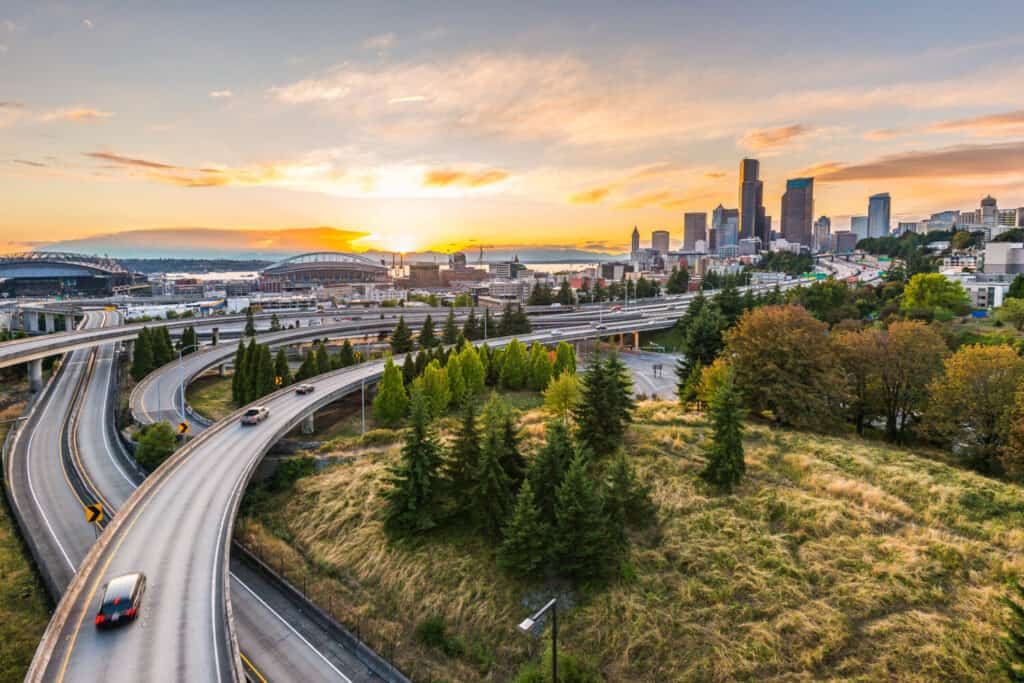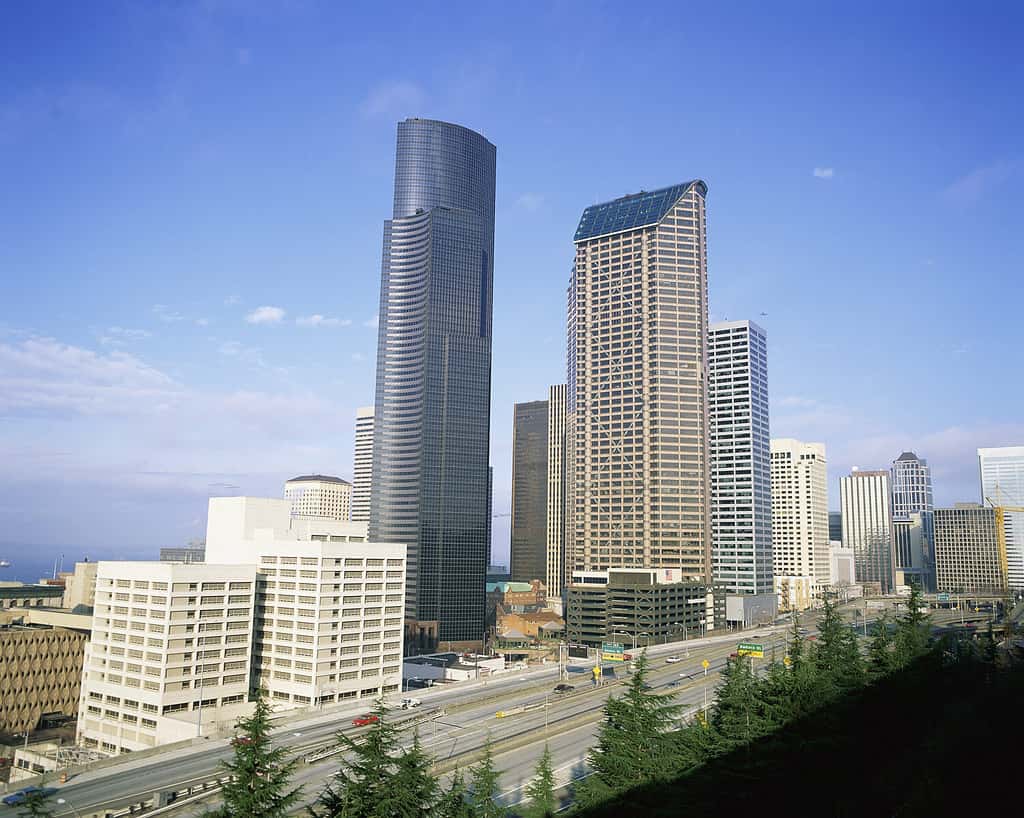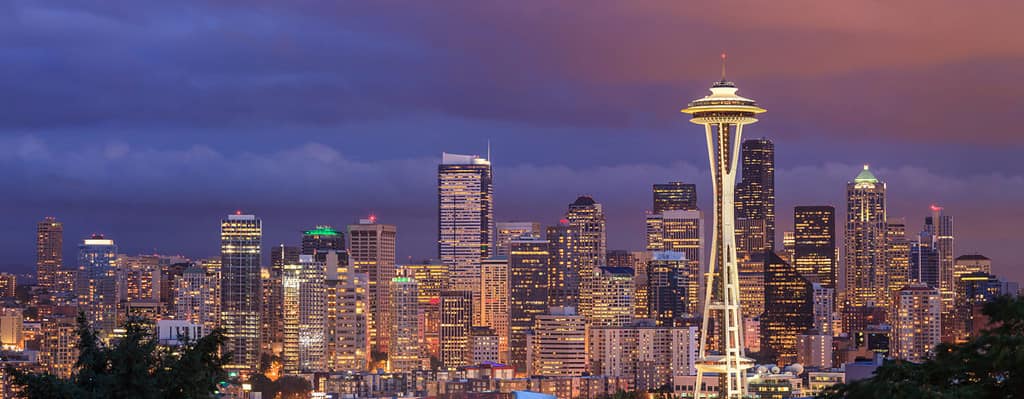Washington is a state in the Pacific Northwest that is home to 7.7 million people. According to the U.S. Census Bureau, the population in this state has grown by almost a million people over the last decade. The state is poised to grow in population well into the future. So, what is the largest city in Washington now and in 2050? We’re going to take a look at the largest city’s current population and see how it is trending for the future.
For this article, we are looking at the population size of the city and not the physical dimensions of the city.
What Is the Largest City in Washington?

Seattle is the largest city in Washington state.
©Checubus/Shutterstock.com
Currently, Seattle is the largest city in Washington. According to the most recent estimates from the U.S. Census Bureau, about 749,256 people live in this part of the state. The second-largest city in Washington is Spokane, a city with about 230,000 people living within its borders. That means Seattle has a massive lead in terms of being the most populous city in the state.
Seattle is a large city located in western Washington along the Puget Sound. The city is known for its frequent rainstorms, beautiful cityscapes, and booming economy.
Even though a city has a lot of people at one time, it does not necessarily mean the population will grow. For example, some large cities like Philadelphia, Boston, and Toledo all dropped in population as a result of the COVID-19 pandemic.
Some of these cities have started to rebound according to recent estimates. However, we won’t have a full accounting of the cities and their populations until the next census.
What Will Be Washington’s Largest City in 2050?

Seattle will continue growing into the future, staying the largest city.
©Joseph Sohm/Shutterstock.com
Washington’s largest city right now is Seattle, and its largest city in 2050 is going to be Seattle as well. In order to understand why this city is poised to be the largest in 2050, it is necessary to look at the city’s past population and growth.
In 2010, Seattle had a population of 608,660. However, this number grew to 737,015 in the official count for the 2020 Census. That is an increase of 128,355 people, representing a total change of 21.1%. This incredible increase in population made Seattle one of the fastest-growing cities in terms of percent change.
The U.S. Census Bureau also tracks estimated population changes every year. In 2022, the estimated population of the city was 749,256. That represents a change of 12,241 people and a total change of 1.66%. While that is not a huge gain in terms of population, it could be a sign of huge growth to come.
The ongoing increases in Seattle’s population seem to indicate that the region may experience robust growth by the time 2050 rolls around.
Predicting Seattle’s 2050 Population
The population of Seattle is set to increase by a significant amount by 2050. Seattle’s Office of Planning and Community Development is operating on the assumption that the city’s population increases by another 240,000 people over the next two decades. That would bring the population up to about 1 million people, and that would occur well before the 2050 deadline.
No other city would have the capability to reach a population of 1 million people before then. Thus, it seems very likely that Seattle will retain the title of the largest city in Washington now and in 2050.
Another interesting point is that the Seattle-Tacoma-Bellevue Metropolitan Area currently has a population of 4,034,000 people. That number is expected to greatly rise by 2050. One recent prediction says that the area could be home to as many as 6 million people by 2050. That would be a huge uptick in the number of residents.
So, one has to wonder why so many people are attracted to this part of Washington that it is growing so much.
Why Are People Attracted to Seattle?

Aside from the beautiful cityscape, the surrounding natural areas and economy are great reasons to live in Seattle.
©Stas Moroz/Shutterstock.com
Millions of people live in the Seattle-Tacoma-Bellevue Metropolitan Area. They live in this region for a lot of reasons. For one thing, the city is in the beautiful Pacific Northwest. Anyone that loves hiking in the forests and mountains will value the opportunity to live in Seattle. After all, beautiful state and national parks, like Olympic National Park, are not all that far away.
Another reason that people love to live in and around Seattle is the available work. The jobs market in the city is humming. That’s not to mention the fact that the city is home to a few major company headquarters such as Amazon and Starbucks.
The existing population of the city provides another insight into why people love the city. Namely, the city only has about 737,015 people living in the area. The metro area is far more densely populated, of course. So, Seattle itself is not very densely populated, giving people the opportunity to live in an urban area without feeling overcrowded.
People will continue to flock to this region for all these reasons and others.
Potential Issues for the Largest City in Washington
The city is rapidly growing, so a greater population density could emerge in the future. For now, though, people in the city can bask in the bountiful beauty of nature. Residents can also enjoy knowing that the jobs market is steady, and more people are going to join their ranks.
Still, some issues could come into play in this area in the future. The need for more housing is ongoing. With an expected addition of almost a third of the existing population, people need a place to stay.
Seattle is the largest city in Washington now and will be in 2050 if all the predictions turn out to be right. With new changes coming to the jobs market and the pending issue of housing in the area, the predictions could go either way.
Thank you for reading! Have some feedback for us? Contact the AZ Animals editorial team.








